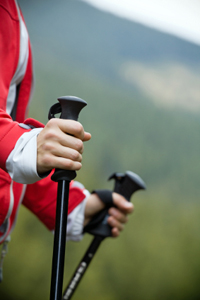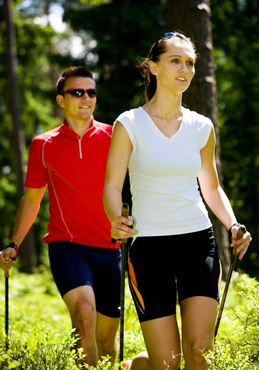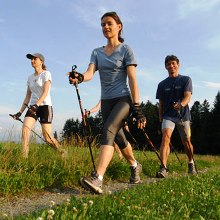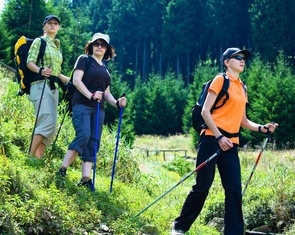With the proper equipment and technique, there’s a dizzying list of benefits to Nordic walking and very little risk. It strengthens the upper body and core, decreases stress on the hips and knees, increases your heart rate and burns 20 per cent more calories.
Letty Kurucz has always loved to walk, cycle and dance. But five years ago arthritis began rapidly creeping into her knees, making almost any kind of physical activity painful. “I felt like an old lady,” says the vivacious 42-year-old today, thinking back to the difficulties she had simply rising out of a chair.
In an attempt to stay active, she tried swimming, group exercise classes and a circuit-style workout, but none was quite the right fit.
When she noticed an upbeat group of women striding through her neighbourhood with Nordic walking poles, she asked her orthopaedic hip and knee surgeon for his input. “He said it would be a ‘magnificent’ exercise choice for me,” says Kurucz.
Today, Kurucz is a Nordic walking devotee.
“Every time I push off with the poles, it releases pressure on my knees,” she says. “And focusing on the coordination and technique takes my mind away from them.”
There’s another really big bonus: she’s 40 pounds lighter thanks to her once-again active lifestyle.
But is Nordic walking just another passing fitness fad?

According to Marja-Leena Keast, PT, Nordic walking is a great fitness activity that can be used in many patient populations. “While it appeals to elderly individuals with stability concerns or those with chronic conditions such as arthritis, it can be beneficial for any age group,” says Keast. “For instance, in Finland it is offered as an alternative training for young army trainees unable to participate in high-impact activities due to joint injury.”
Nordic walking has also recently been investigated as a potential rehabilitation modality for conditions such as Parkinson’s disease, type 2 diabetes, chronic obstructive pulmonary disease and fibromyalgia, and for patients with post-acute coronary syndrome or congestive heart failure, explains Keast.
“Nordic walking is great for cardio-pulmonary rehabilitation patients,” says Keast, “and it can benefit patients with orthopaedic issues such as arthritis and peripheral neuropathies.” However, patients with stability issues should be assessed carefully, she adds, noting that some would be better off using a walker.
Although Nordic walking is still in its infancy in North America, it has been highly popular in countries such as Finland, Switzerland, Sweden and Germany since the 1930s. It was Finnish biathletes and Nordic skiers who created the dry-land training method that people today sometimes refer to as ‘cross-country skiing without skis.’
In Europe, regular citizens, not just athletes, have for years understood the multiple benefits of Nordic walking. Kirsten Lemm, a certified Nordic walking instructor from Kincardine, Ont., says, “It’s so popular there that if you’re out walking briskly without poles, people stare at you and wonder why you’re not using them!” According to recent statistics, two million Germans and 1.5 million Finns are regular Nordic walkers.
The activity is now gaining popularity in Canada as well. “Many Canadians love the outdoors,” says Keast. “There are many beautiful places to enjoy outdoors and do activities such as hiking or cross-country skiing, Nordic walking is a natural addition to these outdoor physical activities that Canadians enjoy doing already.”
With the proper equipment and technique, Nordic walking has many benefits and very little risk, says Lemm. “Research shows that it strengthens the upper body and core, decreases stress on the hips and knees, increases your heart rate and burns 20 per cent more calories.”
According to Suzanne Nottingham, co-author of Nordic Walking for Total Fitness (Human Kinetics), a big part of its appeal is that it offers numerous benefits to people of all fitness levels and ages. “You can practice Nordic walking at almost any place and time,” she says. “The potential to improve your health and fitness is right in the palms of your hands. You can start today and do it for the rest of your life.”
With any sport or activity, it’s important to have the right equipment and instruction, and Nordic walking is no different. “Don’t be tempted to use skiing, hiking or trekking poles, which are designed for totally different purposes,” says Cathy McNorgan of Wellesley, Ontario, a physiotherapist and certified Nordic walking instructor. “Most instructors prefer the convenience of telescoping poles that adjust to suit people of different heights,” she adds. All Nordic walking poles have a spike tip at the bottom (for walking on grass and trails), which is covered with a rubber boot-tip that grips sidewalks and indoor surfaces. Some have a thick ergonomic handles, while others have a thin handle with a wrist strap.
Three ways physiotherapists are using Nordic walking poles in their practice

Canadian physiotherapists have begun to integrate Nordic walking techniques into their practice. It offers many significant potential benefits and can be introduced to a variety of patients at various stages of rehabilitation. For example, Nordic walking poles may help achieve treatment goals with:
Patients who want to improve their gener
al health and fitness. Compared to standard walking, Nordic walking burns more calories, improves posture, and strengthens the core and upper extremities. This makes it an excellent activity for people who need to lose weight and generally be more active. These individuals generally exercise independently with friends or an organized Nordic walking group.
Patients with chronic conditions. Pole walking provides a larger base of support for individuals who have deficits in their balance or coordination skills. The “four-on-the-floor” approach to walking may benefit individuals with chronic conditions who may be able to exercise independently or with minimal assistance. People with early-stage Parkinson’s disease or multiple sclerosis or those who have experienced a brain injury may be considered, and could be introduced to the exercise indoors one-on-one with a physiotherapist. The fluid, rhythmical motor pattern can assist in improving coordination and restoring patterns of movement.
Patients who are post-surgery and/or are in pain. Nordic walking poles were introduced to physiotherapy clients at Vancouver General Hospital’s Acute Spine Program in the fall of 201
0. Using these poles offloads weight from hips, knees and lower spine, and into the upper body, making it ideal for some clients who have arthritis or low back pain, or are easing back into activity after surgery.
Physiotherapist Hilary Jebson works with patients recovering from spinal surgery at Vancouver General Hospital. She reports that the surgeons are pleased with the improved posture made possible with use of the poles. “Walking with poles gives patients an erect posture versus the forward flexed posture they get from a wheeled walker,” explains Jebson, who prefers strapless poles with an ergonomic handle. “The poles also facilitate a normal gait pattern with a heel strike and toe push-off, and pressing down on the base of the handle causes the core muscles to contract and encourages spinal extension.”
For Jebson, an additional benefit of using the poles is that they make it easy for patients to transition to an active post-rehabilitation lifestyle. “The poles help people ambulate post-surgery and then make it easy to transition to using them as a fitness tool once they’re home,” she says. And because many patients have seen other people using Nordic walking poles in their communities, they feel less conspicuous using them, she adds.
Nordic walking offloads the lower extre
mities and loads the upper extremities, which works the upper body harder, requiring more respiratory capacity.
Yet studies show that Nordic walking yields a low rate of perceived exertion (RPE). According to Gail Dechman, an assistant professor in the school of physiotherapy at Dalhousie University in Halifax, research consistently shows that, compared to standard walking, Nordic walking feels less stressful to the body. “Many health benefits are directly related to how hard you work,” says Dechman. “If people can elevate their heart rates without feeling like they’re working harder, that’s fantastic.”
Dechman is one of two speakers presenting sessions on Nordic walking at the CPA Congress 2011. She hopes to share her enthusiasm and raise awareness of the activity during her presentation. “Nordic walking is still very much underappreciated in the physiotherapy world.”
Learning the NORDIC WALKING TECHNIQUE

The Nordic walking technique isn’t difficult for most people to learn. “Most people pick it up the first time they try it,” says physiotherapist and certified Nordic walking instructor Cathy McNorgan. “Then over time they refine their technique; it becomes more natural and they get more out of it.”
To get started, adjust your poles to the appropriate height (look for indications on the poles). Then follow these four basic steps:
- Begin walking and swinging your arms, reaching your arms forward to a long “handshake” position. The arms should move like long pendulums from the shoulders, not from the elbows.
- Keep the poles angled backward so the boot tips are behind you at all times.
- Lift the rib cage high, relax the shoulders and look straight ahead. Relax your hands; there is no need to grip the poles tightly.
- Press down on the base of the handle or the strap (depending on the style of pole) to engage the core and upper back muscles and to propel yourself forward.
How Nordic Walking MEASURES UP
Here are summaries of five important Nordic walking studies:
- A 2010 study found that Nordic walking is 125 per cent more effective than over-ground walking in improving gait speed in a rehabilitation population. Nordic walking participants improved 41 metres on the six-minute walk test and increased their gait speed by 0.21 metres per second; over-ground walking participants improved by 41 metres as well but increased their gait speed by only 0.08 metres per second. Only the Nordic walking group’s gait speed improvement reached statistical significance. (McGill University School of Physical and Occupational Therapy)
- A 2008 study found a significant improvement in timed 10-metre walking, the timed get-up-and-go test, the six-minute walk test and quality of life of subjects with Parkinson’s disease. Compliance was excellent, and there were no adverse effects. (The Movement Disorder Society – American)
- An unpublished 2009 study found that the functional status of cardiac rehabilitation patients with moderate to severe heart failure was 14 per cent greater in those assigned to Nordic walking than in those treated with usual cardiac rehabilitation care. The 12-week study measured distance traveled in the six-minute walk test. (University of Ottawa Heart Institute)
- A 2010 Swedish study found that fibromyalgia patients who Nordic walked twice a week for 15 weeks showed a significantly greater improvement in the six-minute walk test, a significantly larger decrease in exercise heart rate and significantly improved scores on the Fibromyalgia Impact Questionnaire Pain scale, as compared with a low-impact walking group. (Reported in Arthritis Research & therapy, 2010)
- A 2002 study found that caloric expenditure and oxygen consumption increased by an average of 20 per cent and that heart rate increased by 10 beats per minute when Nordic walking poles were used, compared to walking without poles. The rate of perceived exertion was the same for both groups.
Source: comoxphysio.com







